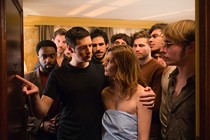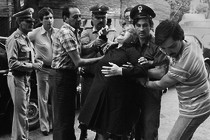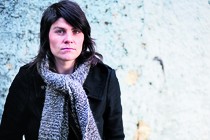When Animals Dream: the wolf and the lamb
- CANNES 2014: An initiation and fantasy story presented at Critics’ Week. The only film on a werewolf presented in Cannes this year

Genre cinema is full of examples of films talking about human phenomena through the metaphor of fantasy. This is the road taken by Danish Jonas Alexander Arnby in When Animals Dream [+see also:
trailer
interview: Jonas Alexander Arnby
film profile], an initiation story on the transformation of a normal girl who discovers she is a werewolf as she transitions from adolescence into adulthood. This film, presented during Critics’ Week at the 67th Cannes Film Festival has all the elements of the new wave of socially conscious horror films, which is sweeping across the cinema scene, from north (Let The Right One In [+see also:
film review
trailer
interview: John Nordling
interview: Tomas Alfredson
film profile]) to south (We Are What We Are). The genre reconciles horror films and independent cinema.
Marie (Sonja Suhl, fragile and powerful at the same time) lives in a small Danish fishing village. Her father (Lars Mikkelsen) takes care of his invalid wife who is afflicted by a mysterious illness, which has left her in a vegetative state. When Marie starts working in a factory, she is confronted with colleague sexual harassment. Her body is changing and her anger only accelerates the process. Her colleagues will soon discover what the price to pay is for messing with a werewolf.
Arnby opens his film with a general atmosphere reminiscent of the intro for series like The Walking Dead and sets his movie in a place that feels lost, borrowing a number of elements from horror films and adding them to Scandinavian social cinema format. He takes time to study his character, with nuances emerging slowly, which will later serve in the last act of vengeance. Just like Carrie, Marie is no classic ingénue who transforms into a monster. Her supernatural condition is already in her DNA as a young woman, and the last part of the film, which takes place after her transformation is no different than a putting into practice of what was shown in the film’s first two acts.
When Animals Dream is gloomy and violent and some moments are gory - but never too much so. His minimalist side, accentuated by the screenplay by Rasmus Birch gets to the point fast, in the same way that the purity of the place contributes to a general impression of purity. This is why the spectator is perturbed every time a wasteful character makes a stain (just like the blood stains in Let the Right One In). Marie is thus brought back to her abnormality within the general ecosystem of the film. This tension is highlighted only once she accepts who she is: her body, her bestiality, and her true enemies who will only have themselves to blame for trying to dig up what was still tender in this brutal world.
(Translated from French)
Did you enjoy reading this article? Please subscribe to our newsletter to receive more stories like this directly in your inbox.

























